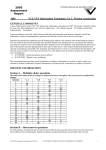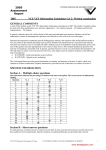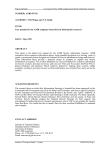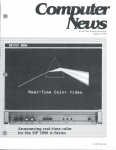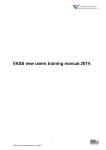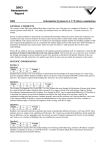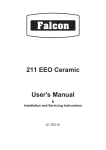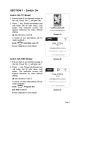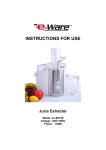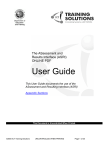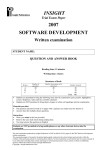Download Scored Assessment in VCE VET Programs
Transcript
SCORED ASSESSMENT IN VCE VET PROGRAMS SUPPORT ADVICE FOR ASSESSORS ACKNOWLEDGMENTS The VCAA gratefully acknowledges the work of the following in the preparation of this booklet: Linda Austin Central Gippsland Institute of TAFE Kevin Baker Victoria University Priscilla Brown St Columba’s College Nadia Casarotto Victoria University Peter Dore-Smith Student Hospitality Training Services Andrea Foot Gordon Institute of TAFE Robert Ford Australian Institute of Tourism and Commerce Sally Fraser Essendon Keilor College Sotira Hatzis Altona North Secondary College John Holland Methodist Ladies’ College Kevork Krozian Forest Hill College Rose Lewanski Victoria University Graham Meadowcroft Print Ideas Margaret Oldham Padua College Sandy Pell Box Hill Institute of TAFE Ron Sawicki Altona Secondary College Jill Scholtz Lilydale Heights Secondary College Connie Tzelepis Wellington Secondary College © Victorian Curriculum and Assessment Authority 2005 Published by the Victorian Curriculum and Assessment Authority 41 St Andrews Place Victoria 3002 ISBN 1 920992 27 8 First published 2005 All rights reserved. Except under the conditions described in the Copyright Act 1968 and subsequent amendments, and except for the exemption below, no part of this publication may be reproduced by any process without permission in writing from the publishers. Photocopying: Victorian schools and TAFE institutes only may photocopy this publication for use by teachers. The artwork on the cover has been reproduced from 2004 VCE Top Designs student work: Sophie Allen Dress ‘Primavera’ 2003 (detail) Copyright remains the property of the artist. SCORED ASSESSMENT IN VCE VET PROGRAMS SUPPORT ADVICE FOR ASSESSORS CONTENTS INTRODUCTION 1 SECTION 1: PHASES OF THE SCORED ASSESSMENT PROCESS 2 PHASE ONE: THE ASSESSMENT PLAN 4 PHASE TWO: DESIGN THE ASSESSMENT TASK 10 PHASE THREE: CONDUCT THE ASSESSMENT 12 SECTION 2: EXAMPLES OF THE SCORED ASSESSMENT PROCESS 13 BUSINESS ADMINISTRATION: SAMPLE 16 HOSPITALITY (OPERATIONS): SAMPLE 26 INFORMATION TECHNOLOGY: SAMPLE 36 APPENDICES 47 1. Visualising evidence 48 2. Selection of task type 49 3. Linking the scoring criteria to the evidence and considerations for design of assessment task 50 4A. Design Rules for Work Performance 51 4B. Design Rules for a Work Project 52 4C. Design Rules for a Product 53 4D. Design Rules for a Portfolio 54 iii INTRODUCTION Scored Assessment in VCE VET programs provides assessors with advice about the process of scoring coursework in VCE VET programs. It guides assessors in the application of the VCAA scoring criteria to the competency-based assessment of VCE VET programs for scored Units 3–4. Most VCE VET programs are drawn from training packages. Where the VCE VET program is curriculum based and therefore delivers modules, the advice contained within this booklet also applies. For the purposes of this booklet, the term ‘unit of competence’ refers also to modules in curriculum documents. This booklet deals with the coursework component of scored assessment for VCE VET programs. Advice about the examination component of each program is provided separately each year. To assist assessors of scored VCE VET programs, this booklet provides advice on: the assessment plan applying the scoring criteria to assessment tasks in the industry specific context integrating the scoring criteria into assessment task design This book is divided into two sections. Section 1 provides an overview of the scored assessment process. Section 2 provides illustrations of how the process may be applied in three VCE VET programs: Business Administration, Hospitality (Operations) and Information Technology. This advice must be read and used in conjunction with the: ■ training package or curriculum document relevant to the scored VCE VET program ■ Office of Training and Tertiary Education (OTTE) Purchasing Guide relevant to the training package ■ VCE VET Assessment Guide relevant to the scored VCE VET program. Support advice for assessors 1 SECTION 1: PHASES OF THE SCORED ASSESSMENT PROCESS Assessment of a student’s level of performance on the tasks completed during the VCE VET Unit 3–4 sequence does not replace competency-based assessment, but is integrated with the usual assessment process through a series of coursework tasks. The task types were selected and developed after consideration of the tasks most commonly used by Registered Training Organisation (RTO) assessors in conducting competency based assessment. The tasks are designed to ensure that both assessment purposes can be met: judgment of the achievement of competence and assessment of the student’s level of performance in the Unit 3–4 sequence of their program. The scoring criteria are the means by which a judgment is made on levels of performance. The critical focus of this booklet is on making the connection between the unit/s of competence being assessed and the scoring process by establishing the links between the evidence of competence and the relevant scoring criteria. The set of scoring criteria and corresponding performance descriptors for each assessment task type are an integral part of the scored assessment process. The performance descriptors for each task type, as identified in the VCE VET Assessment Guides, are generic and may be applied across the range of scored VCE VET programs. The performance descriptors may be more effectively applied where they are translated to reflect the industry specific characteristics of the training and related assessments. The three phases of the scored assessment process are summarised below. PHASE ONE: THE ASSESSMENT PLAN Group units of competence Batch units of competence into three (four for some programs) groups. In some cases a group may consist of only one unit of competence. Identify evidence for assessment Confirm validity of grouping. Consider the four task types Assign a task type to each group of units of competence. Fill out the assessment plan Review the task type scoring criteria PHASE TWO: DESIGN THE ASSESSMENT TASKS Design and develop the task Validate the task design Apply task scoring criteria in the industry specific context 2 SCORED ASSESSMENT IN VCE VET PROGRAMS Support Advice for VCE VET Scored Assessment 2 Figure 1: Design the assessment tasks This figure illustrates the linkages between the steps in this process Design the task within the Link to the scoring criteria rules of the task type Link to the elements of performance criteria and the evidence guides of the units PHASE THREE: CONDUCT THE ASSESSMENT Comply with the task design rules Comply with the rules of the task type selected. Use task to determine competence Judge level of performance Judge the student’s level of performance using the VCAA scoring criteria in the context of the specific industry. Record assessment Use the VCAA record sheets to record student assessments. Support advice for assessors 3 PHASE ONE: THE ASSESSMENT PLAN GROUP UNITS OF COMPETENCE When deciding which units of competence to group you will need to consider: ■ Training package advice or curriculum document ■ VCE VET Assessment Guide TRAINING PACKAGE/CURRICULUM ADVICE Information in the training package assessment guidelines and in the unit/s of competence will assist you with grouping units. The first step in deciding which units of competence to group together is to closely read through each unit of competence to be delivered as part of the VCE VET program. In considering potential groupings, ask the following questions: ■ Do the skills and knowledge required in any of the units overlap or complement each other in relation to job roles and functions? You will need to consider or visualise the evidence in The linkages between the units of competence are also a primary consideration in grouping units. For example, in the Business Services Training Package, co-assessment advice is contained in the unit descriptor at the beginning of each unit of competence. Based on the advice given in the training package, you can co-assess the following units: BSBCMN305A Organise workplace information 30 hours BSBCMN306A Produce business documents 80 hours each unit. ■ Is the scope and context in which the units can be assessed similar? For example, do the units require the student to perform and respond to a similar range of situations and handle a similar range of contingencies? (Refer to the performance criteria and evidence guide of the individual unit of competence.) ■ 4 Can you use similar assessment strategies to assess the units? SCORED ASSESSMENT IN VCE VET PROGRAMS These two units can be grouped and co-assessed where a job role involves the collection, organisation and review of information to design and produce a range of business documents. Check the units of competence in the relevant training package for advice on grouping and co-assessment of units. IDENTIFY EVIDENCE FOR ASSESSMENT VCE VET ASSESSMENT GUIDE The VCE VET Assessment Guide for each program prescribes weighting rules that may determine potential groupings within programs. It is important to be aware of the percentage of the total nominal hours in a student’s VCE VET Unit 3–4 program for which a single task may account. For example, the requirements for Business Administration specify that a task cannot account for more than 52 per cent or 110 hours of a student’s total Unit 3–4 program. Check the appropriate VCE VET Assessment Guide for nominal hours and weighting rules. Once you have made a decision about which units of competence you will group for assessment, you need to analyse each of these units to identify the evidence for assessment. This will enable you to plan and conduct assessment that: ■ reflects and develops the skills and knowledge in the relevant unit/s of competence ■ identifies the skills and knowledge needed to perform a specific job role ■ identifies the evidence required to demonstrate competence ■ consists of assessment tasks that generate the evidence. It is useful to be reminded of the components of a unit of competence. These are represented in Figure 2 (page 6) which helps you to visualise evidence. Support advice for assessors 5 Figure 2: Components of a unit of competence Titles of units of competence and Elements of their descriptors competence Performance describe the identify the criteria describe activity covered work process to the activities in the unit and be undertaken and level of the unit’s in logical performance key features order and are required to related to the demonstrate purpose of the achievement of unit. Elements the element. describe outcomes that contribute to a unit. The range statement relates to the unit of competence as a whole. It allows for different work environments and situations that will affect performance. The evidence guide details the knowledge and skills that underpin competent performance of the unit. It also provides advice on assessment contexts and integrated assessment. VISUALISING THE EVIDENCE An important part of analysing each unit of competence is to visualise the evidence you will require to make a judgment about the student’s competence. Think about: WHAT, HOW AND WHERE? ■ What do the students need to be able to do? ■ How will they do it? ■ Where do they need to do it? The answers to these questions will help you identify the critical aspects of evidence. Looking at each component of a unit of competence in isolation or failing to consider one or more of the components may mean that the assessment may not fully reflect the desired outcomes of the training and may affect a student’s achievement of competence. For example, only looking at the elements and performance criteria means that you will not be assessing underpinning knowledge and skills which are listed in the evidence guide and are critical to the job role. 6 SCORED ASSESSMENT IN VCE VET PROGRAMS CONSIDER THE FOUR TASK TYPES Designing your assessment plan requires you to: ■ Select a task type for each group of units ensuring that you have complied with task selection rules listed in the VCE VET Assessment Guide. ■ Comply with the design rules for each task type and the weighting rule that applies in the relevant scored VCE VET program ■ Consider the VCAA scoring criteria for the selected task type to confirm (or otherwise) the appropriateness of the selection. ■ Confirm that the critical aspects of evidence of the unit/s are covered within the dimensions of the selected task type. SELECTING THE TASK TYPE The task type selected must adequately assess the unit/s of competence you have grouped for assessment purposes. A specific task type should naturally emerge from the critical aspects of evidence required, which will inform your task design. It is important that the task type you select allows for the collection of sufficient evidence to demonstrate competence, as detailed in the unit/s of competence. An appropriate task type may also suggest itself from the title of the unit/s of competence or key words in the elements, evidence guide or range statement. For example, some units of competence involve the preparation of a product. These units are characterised by words such as prepare, produce, develop or design in the unit title or in the elements. A full description of the four task types – Work Performance, Work Project, Product, Portfolio – and the design rules for each are provided in the VCE VET Assessment Guide for each of the scored VCE VET programs. Note: It is likely that you will identify more than one suitable task type but you must select only one for each assessment task. As you progress through the planning process, you may also find that you need to review or reconsider your choice of task type. Illustrations of a process for the selection of task types for Hospitality (Operations), Business Administration and Information Technology are provided in Figure 3 (page 8). The unit of competence itself will also suggest the most appropriate assessment methods. For example, the assessment methods outlined in the Hospitality unit of competence Develop and update food and beverage knowledge include projects, a written or oral test and a workplace activity or role-play. Support advice for assessors 7 Figure 3: Selection of task type (key elements in bolded text) Hospitality (Operations) Unit/s of competence THHBFB03B Provide food and beverage service Possible task type Key considerations in choosing a task type ■ Work Performance Focus of unit is on providing service within restaurant or dining area. ■ Portfolio Can the assessment take place in two different contexts; for example, two different workplaces, times or situations such as day/night, busy/ non busy? 110 hours Requires access to restaurant and equipment. Suggested assessment method of direct observation and questioning is accommodated in the Work Performance task. Task type chosen and rationale for choice Work Performance Work Performance in a simulated work environment that represents industry standard in a school or institute restaurant. Work Performance enables appropriate assessment of the unit through observation and supported by oral and written questions. Portfolio does not assess techniques and processes. Timeframes. Business Administration Unit/s of competence BSBCMN306A Produce business documents 80 hours BSBCMN305A Organise workplace information 30 hours Possible task type Key considerations in choosing a task type ■ Product The critical aspects of evidence require the production of business documents and organisation of workplace information suggesting the production of an item/s. ■ Portfolio ■ Work Performance The critical aspects of evidence require familiarity and use of software applications suggesting knowledge of software applications as well as the application of techniques in the use of the software. Portfolio criteria do not allow assessment of techniques and processes. Requires access to a workplace. Requires access to software and technology. Work Performance was not chosen because unable to access workplace outside the school environment. 8 SCORED ASSESSMENT IN VCE VET PROGRAMS Task type chosen and rationale for choice Product Covered both units of competence in the grouping. Provided for evaluation and problem solving which are not as explicit in the Portfolio task type. The Product task type also includes more emphasis on techniques and processes which is a key part of the evidence for these units. Information Technology (General) Unit/s of competence ICAITS020B Install and optimise system software Possible task type Key considerations in choosing a task type Task type chosen and rationale for choice ■ Work Performance The evidence guides of the units suggest simulated activities that closely reflect the workplace. Work Project ■ Work Project 20 hours ICAITS032B Provide network systems administration 20 hours ICAITD128A Create user and technical documentation 20 Hours Method of assessment is determined by the project lifecycle. Context for assessment recommends the workplace or simulated environment. Evidence guide suggests observation of skills and questioning to assist in assessing competence. Context for assessment of the first unit suggests observation of real or simulated work processes and procedures, quality projects, questioning on underpinning knowledge and skills. The choice of a Work Project provides opportunity to design a task through a scenario and to provide access to support resources that closely reflect the workplace. Projects provide opportunity for assessment of Information Technology units. Requires access to hardware and software. FILL OUT THE ASSESSMENT PLAN The assessment plan pro forma and examples are provided in each VCE VET Assessment Guide. The assessment plan pro forma mirrors the structure on VASS (Victorian Assessment Software System) for enrolling students in the scored VCE VET Unit 3–4 sequence. Each unit of competence in the Unit 3–4 sequence must be assigned to a task, either singly or in a group. For more detailed information on the assessment plan refer to the relevant VCE VET Assessment Guide. Review the task type scoring criteria Find and highlight the links between the evidence for each unit of competence in the VCE VET program and the scoring criteria. Consideration of the scoring criteria for the task type will enable you to develop an assessment task that will encompass the assessment of the unit/s of competence and enable you to make a judgment on the level of performance against the scoring criteria. In Figure 4 (page 11) , a unit of competence from Hospitality (Operations) is used to illustrate the linkage between the generic scoring criteria and the task design process. Support advice for assessors 9 PHASE TWO: DESIGN THE ASSESSMENT TASKS DESIGN AND DEVELOP THE TASK The assessment task is the method through which evidence of competence is collected. The VCE VET scoring criteria are the vehicle by which you will make a judgment on level of performance on the task. The focus of effective assessment task design should be the evidence requirements of the unit/s of competence and the best ways to generate this evidence. The assessor must also comply with the VCAA design rules for each assessment task type. The task design rules are detailed in the VCE VET Assessment Guide for the relevant VCE VET program. The assessment task must reflect the depth, breadth and complexity of the unit/s of competence. In this way the industry context reamins the focus of the assessment task. The task should reflect the industry standard for a specific job role which recognises that different workplaces provide different experiences depending on specific workplace cultures, procedures and organisational requirements. The task description should be clear and concise (1–3 pages) so that students understand what is expected of them in a particular job function and gives them the necessary information to undertake the assessment task. The task should be supported by further discussion and clarification with the students. Students should also be provided with a copy of the VCAA scoring criteria and given the opportunity to discuss the criteria and scoring process. The VCAA provides guidance on timeframes for assessment in each task type. See the relevant VCE VET Assessment Guide for your program area. Examples of assessment tasks for VCE VET programs in Business Administration, Hospitality (Operations) and Information Technology are provided in Section 2 Validating assessment tasks ensures that the assessment of the unit/s of competence will satisfy industry standards and AQTF requirements. When you have designed the task, review it by using the task type checklist in Appendix 4, to identify and address any gaps in your assessment task design. Scored assessment tasks should not be separate from assessments for competence. APPLY SCORING CRITERIA IN THE INDUSTRY SPECIFIC CONTEXT Once you have selected your task type, you need to examine how the evidence of the unit/s of competence links to the VCAA scoring criteria and performance level descriptors for that task type. To ensure that the assessment will enable you to apply the scoring criteria, you will need to look closely at the: ■ task type ■ scoring criteria and performance level descriptors for the task type ■ evidence required from the unit/s of competence. Figure 4 shows how the evidence from a Hospitality (Operations) unit of competence can be linked to each scoring criterion for the Work Performance task type. Applying the VCAA scoring criteria in the indusrty specific context will enable you to derive a score of 1 to 5 for each scoring criterion. The minimum score for a task is 5, and the maximum score is 25. Refer to the VCE VET Assessment Guide. The industry specific performance descriptors do not replace the VCAA generic performance descriptors but enable assessors to judge levels of performance within a specific vocational program and specific industry contexts. VALIDATE THE TASK Contextualising the perfomance level descriptors should be built into your planning process to assist you to translate and apply the VCAA descriptors more effectively. Validating assessment is integral to the quality assurance process. Assessment tasks must be validated by the RTO. Examples of this process of contextualisation are provided in Section 2 (page 13). (page 13). 10 SCORED ASSESSMENT IN VCE VET PROGRAMS Support advice for assessors 11 ■ ability to monitor the service process ■ in the performance of all the above Supervision and performance of work tasks ■ dressing and setting tables for a range of different functions, service styles and service periods ■ waste minimisation techniques ■ plate clearing and carrying techniques ■ ordering and service procedures ■ demonstrated ability to provide complete service within a restaurant or dining area in accordance with established systems and procedures ■ ability to interact positively with customers ■ hygiene and safety issues relevant to food and beverage service ■ knowledge of menus ■ range and usage of standard restaurant equipment ■ typical food and beverage service styles ■ typical workflow structure for service within a food and beverage service environment ■ knowledge of OH&S requirements and demonstrated safe practices ■ demonstrated ability to provide complete service within a restaurant or dining area in accordance with established systems and procedures THHBFB03B Provide food and beverage service Evidence linked to scoring criteria Work organisation Techniques and processes Communication, language and interpersonal skills Application of underpinning knowledge Scoring criteria for WORK PERFORMANCE Hospitality (Operations) The task will need to include oral or written questions to assess underpinning knowledge ■ time constraints. ■ opportunities to provide service according to appropriate legislative and enterprise standards ■ industry realistic conditions such as busy periods, late bookings, walk ins and menu changes ■ interaction with a range of customers ■ different styles of service The task will need to build in: The task will need to be designed so that performance can be observed in a workplace or simulated environment (see Training Package assessment guidelines for assessment in a simulated environment). The assessment task needs to be designed so that it addresses the evidence requirements for ALL components of the unit Considerations for design of assessment task Note: Links between the scoring criteria and evidence required for the unit of competence appear in bold. This table should be read in conjunction with the generic performance descriptors found in the VCE VET Assessment Guide for each scored VCE VET program. Figure 4: Linking the scoring criteria to the evidence and considerations for design of assessment task PHASE THREE: CONDUCT THE ASSESSMENT ■ COMPLY WITH THE RULES ■ USE TASK TO DETERMINE THE COMPETENCE ■ JUDGE LEVEL OF PERFORMANCE ■ RECORD ASSESSMENTS You need to conduct the assessment within the VCAA timeframes as prescribed in the VCE VET Assessment Guide. Conducting assessment requires the assessor to inform the student about the assessment process and to ensure the student is prepared for the assessment. ■ The tasks are designed to ensure that both assessment purposes can be met: judgment of the achievement of competence and assessment of the student’s level of performance in the Unit 3–4 sequence of their program. When you have designed your task and confirmed that your task enables you to assess the unit/s of competence and apply the scoring criteria, you need to think about what you are looking for at each level of performance for the task. On completion of the assessment transfer the scores to the official VCAA documentation that is contained in each VCE VET Assessment Guide. At the conclusion of the assessment it is useful to review and evaluate the process. This may involve: ■ validation of the assessment process during assessment In assessing performance for a Work Performance in Hospitality (Operations), a student would achieve a high score if they were able to provide quality service by applying restaurant systems and procedures including hygiene procedures and anticipating and responding to problems. ■ validation of evidence contributing to judgments made to confirm competence ■ moderation of the scoring of assessment tasks. In assessing performance for a Product in Business Administration, a student would achieve a high score if they were able to produce a range of high quality accurate documents using a range of technological features and applying appropriate design, layout and editing features within designated timeframes and organisational requirements. ■ Was the right task type selected? ■ What worked well? ■ What part of the process needs to be improved? How can this be done? Using the samples provided in Section 2: ■ ■ 12 In assessing performance for a Work Project in Information Technology, a student would achieve a high score if they were able to install and maintain a network system, produce a range of high quality accurate documents using a range of technological features and applying appropriate design, layout and editing features within designated timeframes and organisational requirements. SCORED ASSESSMENT IN VCE VET PROGRAMS Think about the following: SECTION 2: EXAMPLES OF THE SCORED ASSESSMENT PROCESS This section contains examples of the scored assessment process applied to three VCE VET programs: Business Administration, Hospitality (Operations) and Information Technology (General). The application of Phases One and Two in the following examples provides guidance for assessors to plan assessment and to apply the VCAA scoring criteria. This process can be applied to ALL scored VCE VET programs. Each example also shows how the generic scoring criteria have been located in the industry specific context; this is contextualisation of the performance level descriptors. Support advice for assessors 13 BUSINESS ADMINISTRATION BUSINESS ADMINISTRATION: SAMPLE FOR PHASES ONE & TWO Listed below are the units of competence in VCE VET Units 3–4: BSBCMN207A Prepare and process financial/business documents BSBCMN302A Organise personal work priorities and development BSBCMN305A Organise workplace information BSBCMN306A Produce business documents BSBADM305A Create and use databases 40 hours 40 hours 30 hours 80 hours 20 hours THE ASSESSMENT PLAN GROUP UNITS OF COMPETENCE Identify and group appropriate units of competence after carefully considering advice in the relevant training package, the VCAA requirements in the relevant VCE VET Assessment Guide and the work focus of the units. The following units were grouped: BSBCMN305A Organise workplace information BSBCMN306A Produce business documents This group of units for the proposed assessment task represents a total of 110 nominal hours and is within the VCAA requirement of not exceeding 52 per cent of the total nominal hours for a student’s Unit 3–4 sequence in the Business Administration program (refer to the VCE VET Assessment Guide). Further guidance from the assessment advice within the units of competence also influenced the grouping. The decision to group the two units of competence was based on advice about co-assessment provided in the Business Services Training Package. IDENTIFY EVIDENCE FOR ASSESSMENT Review each unit of competence in your grouping noting the elements, performance criteria, range statement and evidence guide including the critical aspects of evidence, underpinning skills and knowledge. Identify the linkages between the units of competence. It is critical to have a sound understanding of the skills and knowledge students will have to be able to demonstrate through the assessment task. Figure 5 represents a visualisation of the evidence required by the two units of competence identified above. 16 SCORED ASSESSMENT IN VCE VET PROGRAMS Figure 5: Visualising evidence Refer to the Performance Criteria and Critical Aspects of Evidence in the units of competence WHAT do the students need to be able to do? BSBCMN305A Organise workplace information BSBCMN306A Produce business documents ■ provide accurate information for defined purposes ■ select and apply appropriate technology and software ■ maintain and handle data and documents systematically ■ design and produce business documents using three software applications ■ check and review data for relevance and accuracy ■ use a range of functions which enhance the presentation of readability of the document ■ present information and data clearly ■ identify and comply with organisational requirements ■ use business technology to manage information ■ use data storage options ■ apply OHS procedures for set up of workstation and operation of computer CONSIDER THE FOUR TASK TYPES Select a task type and design a task that will allow for collection of evidence for assessment and that captures the scoring criteria. SELECT THE TASK TYPE To do this you need to: on different task types. It is likely that you will identify ■ ■ ■ Of the three assessment tasks selected for the Unit 3–4 sequence in this program, at least two must be based select a task type that complies with VCAA design rules more than one suitable task type but you must select consider the VCAA scoring criteria to confirm appropriateness of the selection As you progress through the planning process, you may assign the unit/s of competence to the task type. choice of task type. only one for the assessment. also find that you need to review or reconsider your Figure 6 (page 18) shows the process for the selection of an appropriate task type for the group of units selected. Support advice for assessors 17 Figure 6: Selection of task type Unit/s of competence Possible task types Key considerations Task type chosen and rationale Business Administration BSBCMN306A Produce business documents ■ Product ■ Portfolio ■ Work Performance BSBCMN305A Organise workplace information The critical aspects of evidence require the production of business documents suggesting the production of an item/s. The Product design rules would enable reliable assessment of these units. The critical aspects of evidence require familiarity and use of software applications suggesting knowledge of software applications as well as the application of techniques in the use of the software. The Portfolio scoring criteria do not allow assessment of techniques and processes. Product Covered both units of competence in the grouping. Provided for evaluation and problem solving which are not as explicit in the Portfolio. The Product also includes more emphasis on techniques and processes which is a key part of the evidence for these units. Requires access to a workplace. Requires access to software and technology. Advice from RTO. Work Performance was not chosen because unable to access workplace outside the school environment. FILL OUT THE ASSESSMENT PLAN The VCE VET Business Assessment Guide provides detailed information about the rules relating to the Assessment Plan. Assessors must be familiar with these requirements. A pro forma Assessment Plan and completed sample are found in the attachments in the VCE VET Assessment Guide. 18 SCORED ASSESSMENT IN VCE VET PROGRAMS DESIGN THE ASSESSMENT TASKS DESIGN AND DEVELOP THE TASK Link the scoring criteria to the evidence Having chosen the Product to assess this group of competencies, we need to identify the links between the VCAA scoring criteria and the evidence for the units of competence. Linking the VCAA scoring criteria to the evidence required for the units of competence, will assist you to develop an appropriate assessment task. Applying the scoring criteria in the industry specific context provides further definition to the task. This contextualisation of the performance level descriptors provides an important link between the evidence to be collected through the task and your judgment of level of performance. A task design checklist, to assist you to check that you have addressed the essential requirements and to review your task, is provided in Appendix 4. Figure 7 (page 22) illustrates how to link the scoring criteria to the industry specific context. Consideration of the performance level descriptors for the task will enable you to develop an assessment task that will encompass the assessment of the unit/s of competence and enable you to make a judgment on the level of performance against the scoring criteria. Refer to Section 1 of this advice material to review information about task design. The following is an example of a Business Administration Product assessment task. Support advice for assessors 19 Business Administration – Product You will also need to use a minimum of three different types of technology and three software applications to produce your documents. Technology may include: Student Information: ■ computers Task overview ■ scanners The following assessment task is part of your assessment for VCE VET Business Administration. You will be required to work in the role of an administrative assistant to produce various business documents, using a range of technology and software. You will be required to plan and produce supporting documents for a parent information evening at your school. ■ photocopiers ■ printers. This assessment task assesses the following units of competence. Software may include: ■ word processing packages ■ database packages ■ spreadsheet packages ■ presentation packages. BSBCMN305A Organise workplace information BSBCMN306A Produce business documents Specific requirements of the task Part 1: Planning the process The task is made up of three parts: Part 1: Planning the process Part 2: Producing the documents Part 3: Evaluating the process You will be required to produce a minimum of three different types of business documents to support the parent information evening. You will need to choose two items from Group 1 and an item from Group two, detailed below. Group 1 ■ Subject information sheets for 2–3 subject areas ■ A program for the evening ■ An invitation to parents ■ A registration form following information: ■ a list of the documents you will be producing ■ a list of the technology and software applications required to complete each component of the Product ■ the information you will need to collect ■ sources of information ■ design and layout information for each document ■ people to consult in the development of each document ■ methods for seeking feedback for each document ■ organisational requirements for document design. Part 2: Producing the documents Group 2 ■ A PowerPoint presentation to be presented on the night ■ A school webpage about the event 20 You will be required to submit a written plan of approximately 500–700 words. You will be given time in class to write up your plan. Your plan should include the SCORED ASSESSMENT IN VCE VET PROGRAMS Up to 15 hours of class time will be allowed for you to produce your documents. Part 3: Evaluating the process When you have completed your documents you will be required to participate in an interview with your assessor in which you will be asked to answer some questions about how you completed your task. These questions could include the following: ■ ■ Did you need to make any adjustments to your initial plan? Describe these adjustments and why you needed to make them. What problems did you encounter in the planning and production of the documents? How did you deal with these problems? ■ Would you change your information collection processes next time? Why/why not? ■ Was the time allocated sufficient for you to produce documents to the standard required? Assessment of the task The five scoring criteria for this assessment task are: 3. Identify and solve problems with accuracy and ability to make decisions. 4. Explain if your product reflects your initial plan and meets required function and purpose. 5. Demonstrate mastery of the technical skills to complete the Product. Resources You will have access to computers and a range of software. Assessment due date/s Assessor notes: Explain criteria for assessment to students Students should have access to the VCE VET Scoring Criteria for the Product and you will need to explain how the task is linked to the criteria. ■ Application of underpinning knowledge ■ Planning, organisation and implementation Validate the task design ■ Problem solving ■ Evaluation of Product against plan or intended outcome When you have designed the Business Administration assessment task, check that it complies with the training package assessment guidelines and the VCAA coursework design rules. ■ Techniques and processes To obtain a high score, you will need to do the following: 1. Demonstrate a thorough understanding of the concepts underpinning the Product and apply them effectively. This includes: ■ organisational policies and procedures ■ features and functions of computer applications ■ document design ■ record keeping systems. 2. Display a high level of planning and organisation when you are developing the Product. You will need to explain and evaluate the key steps in planning and developing the Product. The checklist provided in Appendix 4 has been designed to enable you to check your task and to identify and address gaps. It allows you to review the task to confirm it complies with the VCAA design rules. Apply task scoring criteria in the industry specific context Figure 7 (page 22) illustrates the application of industry specific performance level descriptors to the Business Administration assessment task. Refer to Section 1 to review information on how these performance level descriptors were developed. Support advice for assessors 21 22 SCORED ASSESSMENT IN VCE VET PROGRAMS Planning, organisation and implementation Application of underpinning knowledge VCE VET Scoring Criteria Produces a more detailed plan for production of documents. Prioritises and adjusts given tasks as required. Selects and uses a range of interpersonal skills to access information from given sources. Identifies feedback required and seeks it from appropriate sources. Clarifies and identifies sources of feedback required. Produces documents on time with minimal support. Prioritises given tasks. Uses limited interpersonal skills to access information from given sources. Asks for general feedback. Produces documents on time with extensive support. Describes own place in structure of organisation/business and its relationship to immediately related roles. Identifies own place in structure of organisation/business. Produces a simple plan outline for production of documents. Uses an increasing range of industry terminology to describe the functions and features of a range of computer applications and equipment. Uses basic industry terminology to identify the functions and features of a limited range of computer applications and equipment. Uses functions and features accurately and safely. 3 Selects relevant organisational requirements and systems from a range of organisational requirements and applies these to the production of task documents. 2 Level of Performance Identifies limited and immediate organisational requirements and systems from given information and applies these to the production of task documents. 1 PRODUCT contextualised for Business Administration Figure 7: Identifying evidence against criteria and performance descriptors 4 Produces documents ahead of time independently. Identifies, seeks and acts on feedback. Evaluates feedback and incorporates if relevant. Selects, adapts and uses a range of interpersonal skills to access information from own sources. Creates and evaluates own priorities. Produces a detailed plan including contingency plans. Describes own place in structure of organisation/business and its relationship to the broader organisation/business structure. Uses an extensive range of industry terminology to explain the functions and features of an extensive range of computer applications and equipment and their application to the task. Refers to quality manuals and procedures and organisational style guides. Locates, interprets and analyses organisational requirements and systems and applies these to the production of task documents. 5 Support advice for assessors 23 Describes gaps/problems and suggests modifications. Needed little support to solve problems. Product effectively meets required function and purpose. Identifies gaps/problems and suggests modifications. Needs support to solve problems. Product meets required function and purpose. Selects, uses and combines technology and software from a wider range of technology and software applications accurately and according to OHS requirements to enhance appearance of documents. Uses given format as a guide. Reads own work, documents possible changes and makes decisions about required changes. Completes documents on time with minimal direction. Uses limited technology and software accurately and according to OHS requirements to produce documents to a basic standard. Uses supplied format for copies. Reads own work and identifies where minor changes may need to be made. Completes documents on time with direction. 4 Completes documents on time with no direction. Reads own work, systematically documents possible changes and makes decisions about required changes and implements appropriately. Locates samples of suitable formats and adapts these to own task. Defines outcome for use of technology. Uses technology and software to meet changing requirements. Selects, uses and combines technology and software from an extensive range to maximise presentation and appearance of documents. Product exceeds required function and purpose and adds value to the outcome. Solved problems independently. Analyses gaps, suggests modifications and reasons for these. Analyses how the process undertaken relates to original plan. Identifies and clarifies original objectives in all respects. Anticipates problems and selects from a range of processes to achieve the best solution. Seeks feedback on solutions proposed. Implements effective solutions. 5 Please note: The industry specific performance descriptors do not replace the VCAA generic performance descriptors. Assessors must use the VCE VET Scoring Criteria sheets and VET Coursework Assessment Record sheets that are provided in the VCE VET Assessment Guide. Techniques and processes Documents process used and compares to original plan. Compares processes used in original plan. Describes main steps in plan and process Identifies and clarifies original objectives in most respects. Identifies and clarifies original objectives in critical respects. Identifies complex problems and selects appropriate solutions. Implements selected solution/s. 3 Evaluation of product against plan or intended outcome 2 Identifies routine problems and applies given solutions. 1 Level of Performance Problem solving VCE VET Scoring Criteria PRODUCT contextualised for Business Administration HOSPITALITY (OPERATIONS) HOSPITALITY (OPERATIONS): SAMPLE FOR PHASES ONE AND TWO Listed below are the units of competence in VCE VET Units 3–4. Refer to the VCE VET Hospitality (Operations) program booklet and the VCE VET Hospitality (Operations) Assessment Guide for the requirements for selection of the VCE VET Unit 3–4 sequence. THHBFB03B THHBFB10B THHBFB02B THHBFB11B THHBFB12A THHBCC02B THHBCC03B THHBCC04B THHBKA03B THHGHS02B THHBCAT01B Provide Food and Beverage Service Prepare and Serve Non-alcoholic Beverages Provide a Link between Kitchen and Service Areas Develop and Update Food and Beverage Knowledge Prepare and Serve Espresso Coffee Prepare Appetisers and Salads Prepare Stocks, Sauces and Soups Prepare Vegetables, Eggs and Farinaceous Dishes Receive and Store Kitchen Supplies Clean Premises and Equipment Prepare Foods according to Dietary and Cultural Needs 110 hours 15 hours 10 hours 50 hours 30 hours 25 hours 35 hours 45 hours 10 hours 12 hours 70 hours THE ASSESSMENT PLAN GROUP UNITS OF COMPETENCE Identify and group appropriate units of competence after carefully considering advice in the relevant Training Package, the VCAA requirements in the relevant VCE VET Assessment Guide and the work focus of the units. The following unit of competence will be assessed on its own: THHBF03B: Provide Food and Beverage Service Advice from the VCAA Hospitality Assessment Guide on the selection of units that represent an even spread of nominal hours to enable equal weighting across the three tasks was considered. The unit for the proposed assessment task represents a total of 110 nominal hours and is within the requirement of not exceeding 62 per cent of the total nominal hours in a student’s Unit 3–4 sequence. Further guidance from the assessment advice within the unit of competence, also influenced the decision to assess this as a single stand alone unit. It was decided to assess this unit of competence on its own as it is a large unit – 110 hours. If this student is completing a 185 hour Unit 3–4 sequence, this meets VCAA requirements that no task may account for more than 62 per cent of the total nominal hours in a student’s Unit 3–4 sequence. IDENTIFY EVIDENCE FOR ASSESSMENT Review each unit of competence in your grouping noting the elements, performance criteria, range statement and evidence guide including the critical aspects of evidence, underpinning skills and knowledge. Identify the linkages between the units of competence. It is critical to have a sound understanding of the skills and knowledge students will have to be able to demonstrate through the assessment task. Figure 8 represents a visualisation of the evidence required by the unit of competence identified above. 26 SCORED ASSESSMENT IN VCE VET PROGRAMS Figure 8: Visualising evidence Refer to the Performance Criteria and Critical Aspects of Evidence in the unit of competence WHAT do the students need to be able to do? THHBFB03B: Provide Food and Beverage Service ■ Demonstrated ability to provide complete service within a restaurant or dining area in accordance with established systems and procedures ■ Ability to interact positively with customers ■ Ability to monitor the service process ■ Knowledge of OH&S requirements and demonstrated safe practices CONSIDER THE FOUR TASK TYPES Select a task type and design a task that will allow for collection of evidence for assessment and that captures the scoring criteria. SELECT THE TASK TYPE To do this you need to: on different task types. It is likely that you will identify ■ ■ ■ Of the three assessment tasks selected for the Unit 3–4 sequence in this program, at least two must be based select a task type that complies with VCAA design rules more than one suitable task type but you must select consider the VCAA scoring criteria to confirm appropriateness of the selection As you progress through the planning process, you may assign the unit/s of competence to the task type. choice of task type. only one for the assessment. also find that you need to review or reconsider your Figure 9 (page 28) shows the process for the selection of an appropriate task type for the group of units selected. Support advice for assessors 27 Figure 9: Selection of task type Unit/s of competence Possible task types Key considerations for task selection Task type chosen and rationale t Hospitality (Operations) THHBFB03B Provide food and beverage service ■ Work Performance Focus of unit is on providing service within restaurant or dining area. ■ Portfolio Can the assessment take place in two different contexts for example two different workplaces, times or situations such as day/night, busy/ non busy? Work Performance Role-play not suitable, simulated work environment must represent industry standard of service. Focus of unit is on application of skills and knowledge on the job. Requires access to restaurant and equipment. Suggested assessment method of direct observation and questioning. Portfolio does not assess techniques and processes. Timeframes. Consult with RTO to discuss suitable task types. FILL OUT THE ASSESSMENT PLAN The VCE VET Hospitality (Operations) Assessment Guide provides detailed information about the rules relating to the Assessment Plan. Assessors must be familiar with these requirements. A pro forma Assessment Plan and completed sample are found in the attachments in the VCE VET Assessment Guide. 28 SCORED ASSESSMENT IN VCE VET PROGRAMS DESIGN THE ASSESSMENT TASKS DESIGN AND DEVELOP THE TASK Link the scoring criteria to the evidence Having chosen the Work Performance to assess this unit of competence, we need to identify the links between the VCAA scoring criteria for the Work Performance task type and the evidence for the unit of competence identified: THHBFB03B Provide Food and Beverage Service. Linking the VCAA scoring criteria to the evidence required for the units of competence, will assist you to develop an appropriate assessment task. Applying the scoring criteria in the industry specific context provides further definition to the task. This contextualisation of the performance level descriptors provides an important link between the evidence to be collected through the task and your judgment of level of performance. A task design checklist, to assist you to check that you have addressed the essential requirements and to review your task, is provided in Appendix 4. Figure 10 (page 32) illustrates how to link the scoring criteria to the industry specific context. Consideration of the performance level descriptors for the task will enable you to develop an assessment task that will encompass the assessment of the unit of competence and enable you to make a judgement on the level of performance against the scoring criteria. Refer to Section 1 of this advice material to review information about task design. The following is an example of a Hospitality (Operations) Work Performance task. Support advice for assessors 29 Hospitality (Operations) – Work Performance Student information: Task overview The following assessment task is part of your assessment for VCE VET Hospitality (Operations). The task requires you to work in the role of a waiter/food and beverage attendant in Victoria’s Restaurant for six sessions each of 5 hours duration. This assessment task assesses the following unit of competence: Part 2: Oral or written test on underpinning knowledge in unit This part of the task will consist of questions in the following areas: ■ restaurant rules and procedures ■ setting tables ■ cutlery identification ■ sequence of service. Assessment of the task The five scoring criteria for this assessment task are: THHBF03B: Provide Food and Beverage Service ■ Application of underpinning knowledge The task is made up of two parts: ■ Communication, language and interpersonal skills Part 1: Application of practical activities in the workplace ■ Techniques and processes ■ Work organisation Part 2: Oral or written test on underpinning knowledge in unit. ■ Supervision and performance of work tasks. You will be required to apply at least two of the following different styles of service: ■ table d’hote ■ a la carte ■ buffet ■ breakfast ■ function. To obtain a high score, you will need to do the following: ■ Demonstrate a thorough understanding of the key concepts underpinning food and beverage service. This includes understanding organisational requirements, equipment features and functions and menu knowledge. ■ Select and use a range of appropriate communication techniques with colleagues and customers. This includes greeting customers, checking customer satisfaction and displaying interpersonal skills such as punctuality and courtesy. ■ Effectively perform technical skills and procedures in food and beverage service. This includes monitoring of workflow, effective time management and safe work practices. ■ Demonstrate good planning and organisational skills in carrying out functions in the workplace. ■ Perform tasks independently and accurately. Specific requirements of the task Part 1: Application of practical activities in the workplace You will be observed undertaking specific tasks in the workplace. As a professional waiter you will be observed as you: ■ prepare and maintain the work area ■ maintain good customer and staff relations ■ make recommendations and assist guests in making selections Resources ■ take and record orders ■ serve and clear food and beverages Access to a restaurant or hospitality training centre. ■ closedown the restaurant. Assessment due date/s 30 SCORED ASSESSMENT IN VCE VET PROGRAMS Assessor notes: Explain criteria for assessment to students Students should have access to the VCE VET Scoring Criteria for the Work Performance and you will need to explain how the task is linked to the criteria. Validate the task design When you have designed the Hospitality (Operations) assessment task, check that it complies with the training package assessment guidelines and the VCAA coursework design rules. The checklist provided in Appendix 4 has been designed to enable you to check your task and to identify and address gaps. It allows you to review the task to confirm it complies with the VCAA design rules. Apply task scoring criteria in the industry specific context Figure 10 (page 32) illustrates the application of industry specific performance level descriptors to the Hospitality (Operations) assessment task. Refer to Section 1 to review information on how these performance level descriptors were developed. Support advice for assessors 31 32 SCORED ASSESSMENT IN VCE VET PROGRAMS Communication, language and interpersonal skills Application of underpinning knowledge VCE VET Scoring Criteria Identifies and distinguishes features of an extensive range of food and beverage styles and suitability to different dining environments. Is familiar with the organisation’s menu and can list, describe and make informed and detailed recommendations and suggestions to customers. Identifies and distinguishes features of food and beverage service styles in the hospitality industry. Is familiar with the organisation’s menu and can list, describe and make detailed recommendations to customers. Selects and uses a range of interpersonal skills to interact with customers and staff in a dining environment. Takes and records order, then confirms order with customer and relays order to appropriate staff. Clarifies instructions and asks questions. Identifies a range of food and beverage service styles directly related to the task (job role). Is familiar with the organisation’s menu and can list, describe and make recommendations to customers. Communicates , uses appropriate language, interacts and addresses customers and staff within a dining environment. Records orders legibly and relays order to appropriate staff. Follows given instructions. Clarifies instructions and acts on feedback given. Anticipates customer needs, takes order, relays order to appropriate staff and keeps customer informed. Selects, uses and adapts a wide range of interpersonal skills including awareness of register and body language to interact with a wide range of customers in diverse dining environments. Identifies an extensive range of equipment and explains their functions. Locates and applies the organisation’s policies and procedures including OHS and hygiene requirements to provide a high standard of service within a restaurant or dining area. 5 Identifies and explains the functions of a range of equipment. 4 Identifies suitable equipment relevant to perform the task. 3 Selects relevant organisational requirements to provide a good standard of service within a restaurant or dining area. 2 Identifies and applies relevant OH&S and hygiene organisational requirements within a restaurant or dining area. 1 Level of Performance WORK PERFORMANCE contextualised for Hospitality (Operations) Figure 10: Identifying evidence against criteria and performance descriptors Support advice for assessors 33 Completes task with direction. Completes task with some or minimal support. Has a clear understanding of the job function in the workplace. Identifies problems in the service process, then selects and implements appropriate solution. Identifies and solves routine problems. Completes task with direction. Prioritises and adjusts given tasks within the service process as required. Prioritises given tasks within the service process. Uses equipment correctly and can explain functions. Uses equipment correctly. 3 Selects and applies techniques and processes for different restaurant and dining environments. 2 Applies appropriate techniques and processes in different restaurant and dining environments. 1 Level of Performance 4 Completes task independently. Has a thorough understanding of the job function in the workplace. Anticipates problems in the service process and selects from a range of processes to achieve the best solution and seeks feedback. Identifies and evaluates own priorities within the service process. Uses equipment correctly and can provide detailed explanation of functions. Selects, implements and adjusts a range of techniques and processes to different restaurants and dining environments. 5 Please note: The industry specific performance descriptors do not replace the VCAA generic performance descriptors. Assessors must use the VCE VET Scoring Criteria sheets and VET Coursework Assessment Record sheets that are provided in the VCE VET Assessment Guide. Supervision and performance of work tasks Work organisation Techniques and processes VCE VET Scoring Criteria WORK PERFORMANCE contextualised for Hospitality (Operations) INFORMATION TECHNOLOGY INFORMATION TECHNOLOGY (GENERAL): SAMPLE FOR PHASES ONE AND TWO Listed below are the units of competence in VCE VET Units 3–4. ICAITU018C ICAITD128A ICAITU126B ICAITS032B ICAITU019C ICAITS031B ICAITS020C Develop macros and templates for clients using standard products Create user and technical documentation Use advanced features of computer applications Provide network systems administration Migrate to new technology Provide advice to clients Install and optimise system software 60 hrs 20 hrs 40 hrs 20 hrs 20 hrs 40 hrs 20 hrs THE ASSESSMENT PLAN GROUP UNITS OF COMPETENCE Identify and group appropriate units of competence after carefully considering advice in the relevant training package, the VCAA requirements in the relevant VCE VET Assessment Guide and the work focus of the units. The following units were grouped: ICAITS020C Install and optimise system software ICAITS032B Provide network systems administration ICAITD128A Create user and technical documentation This group of units for the proposed assessment task represents a total of 60 nominal hours and is well within the VCAA requirement of not exceeding 50 per cent of the total nominal hours for the Unit 3–4 sequence in the Information Technology (General) program (refer to the VCE VET Assessment Guide). Further guidance from the assessment advice within the units of competence also influenced the grouping. For example, it is advised that ICAITS032B Provide network systems administration can be co-assessed with the other units of competence included in this group. IDENTIFY EVIDENCE FOR ASSESSMENT Review each unit of competence in your grouping noting the elements, performance criteria, range statement and evidence guide including the critical aspects of evidence, underpinning skills and knowledge. Identify the linkages between the units of competence. It is critical to have a sound understanding of the skills and knowledge students have to be able to demonstrate through the assessment task. Figure 11 represents a visualisation of the evidence required by the three units of competence identified. 36 SCORED ASSESSMENT IN VCE VET PROGRAMS Figure 11: Visualising evidence Refer to the Performance Criteria and Critical Aspects of Evidence in the units of competence WHAT do the students need to be able to do? ICAITS020B Install and optimise system software ICAITS032B Provide network systems administration ICAITD128A Create user and technical documentation ■ determine operating system requirements in line with organisational guidelines and budget ■ provide client access and security ■ maintain network integrity and perform diagnostic tests ■ define and document reference material to use, support and maintain system ■ formulate a disaster recovery plan ■ determine documentation standards and requirements ■ provide the client with an optimised network that complies with organisational guidelines ■ produce technical software documentation in line with project plan ■ demonstrate OHS requirements in relation to ergonomic and environmental factors ■ create client user documentation that is clear and coherant ■ identify vendor specifications and requirements for installation ■ install and improve system performance with minimum disruption to clients ■ set up configuration and procedures ■ review and update documentation ■ provide instruction to the client ■ demonstrate OHS requirements relating to the use of equipment ■ demonstrate OHS requirements in relation to ergonomic and environmental factors CONSIDER THE FOUR TASK TYPES Select a task type and design a task that will allow for collection of evidence for assessment and that captures the scoring criteria. SELECT THE TASK TYPE To do this you need to: on different task types. It is likely that you will identify ■ ■ ■ Of the three assessment tasks selected for the Unit 3–4 sequence in this program, at least two must be based select a task type that complies with VCAA design rules more than one suitable task type but you must select consider the VCAA scoring criteria to confirm appropriateness of the selection As you progress through the planning process, you may assign the unit/s of competence to the task type. only one for the assessment. also find that you need to review or reconsider your choice of task type. Figure 12 (page 38) shows the process for the selection of an appropriate task type for the group of units selected. Support advice for assessors 37 Figure 12: Selection of task type Information Technology (General) Unit/s of competence ICAITS020C Install and optimise system software Possible task types Key considerations in choosing a task type Task type chosen & rationale for choice ■ Work Performance The evidence guide of the units suggests simulated activities that closely reflect the workplace. Work Project ■ Work Project ICAITS032B Provide network systems administration ICAITD128A Create user and technical documentation The units suggest that method of assessment is determined by the project lifecycle. The context for assessment is the workplace or simulated environment. Evidence guide suggests observation of skills and questioning to assist in assessing competence. The choice of a Work Project provides the opportunity to design a task through a scenario and to provide access to support resources that closely reflect the workplace. Projects provide opportunity for assessment of Information Technology units. Context for assessment of the first unit suggests observation of real or simulated work processes and procedures, quality projects, questioning on underpinning knowledge and skills. Requires access to hardware and software. FILL OUT THE ASSESSMENT PLAN The VCE VET Information Technology Assessment Guide provides detailed information about the rules relating to the Assessment Plan. Assessors must be familiar with these requirements. A pro forma Assessment Plan and completed sample are found in the attachments in the VCE VET Assessment Guide. 38 SCORED ASSESSMENT IN VCE VET PROGRAMS DESIGN THE ASSESSMENT TASK DESIGN AND DEVELOP THE TASK Link the scoring criteria to the evidence Having chosen the Work Project to assess this group of competencies, we need to identify the links between the VCAA scoring criteria and the evidence for the units of competence. Linking the VCAA scoring criteria to the evidence required for the units of competence, will assist you to develop an appropriate assessment task. Applying the scoring criteria in the industry specific context provides further definition to the task. This contextualisation of the performance level descriptors provides an important link between the evidence to be collected through the task and your judgment of level of performance. A task design checklist, to assist you to check that you have addressed the essential requirements and to review your task, is provided in Appendix 4. Figure 13 (page 44) illustrates how to link the scoring criteria to the industry specific context. Consideration of the performance level descriptors for the task will enable you to develop an assessment task that will encompass the assessment of the unit of competence and enable you to make a judgment on the level of performance against the scoring criteria. Refer to Section 1 of this advice material to review information about task design. The following is an example of an Information Technology Work Project. Support advice for assessors 39 Information Technology (General) – Work Project Student information: Task overview The following assessment task is part of your assessment for VCE VET Information Technology (General). You will take on the role of Assistant System Administrator to complete this assessment task. The assessment task involves a Work Project, where you will be required to undertake a planning exercise which will require you to investigate operating system requirements, make recommendations for implementation, implement and support the new system. The Work Project involves planning and investigation to: ■ determine new network operating system requirements in line with organisational guidelines and budget to present to management to consider for implementation ■ install the system and provide network system administration; and ■ create user and technical documentation. The Work Project will be documented in a written report that includes your project plan and support technical documentation (approximately 1200–1500 words). This assessment task assesses the following units of competence: ICAITS020C Install and optimise system software ICAITS032B Provide network systems administration ICAITD128A Create user and technical documentation 40 SCORED ASSESSMENT IN VCE VET PROGRAMS Time allowed: 15 hours You will be given approximately 5 hours to determine system requirements and to document an implementation plan and 10 hours to complete the project – install the system, provide network administration and develop user documentation. This task is the final assessment for these three units of competence. It will also provide you with the opportunity to be assessed on your level of performance for a study score for this VCE VET program. Study scores are optional and you may choose not to receive a study score. However, you will be required to complete the assessment task to determine competence. Assessment of competence also involves ongoing assessment, therefore the work you have undertaken during class for these units, is part of your assessment. Specific requirements of the task This Work Project is made up of three parts: Part 1: Develop a project plan and investigate project requirements Part 2: Implement your project plan Part 3: Report on project outcomes Below is a scenario for the Work Project with instructions on completing the assessment task. Scenario: As Assistant Network Administrator working for an online holiday accommodation agency (Ozzie Holidays) you have been set a Work Project to investigate the implementation of an operating system to meet the growing needs of the organisation. To do this you will have to devise a project plan. Part 1: Develop a project plan and investigate project requirements 1. Read the scenario and identify and document project tasks and timeline (implementation plan). 2. Investigate and document system requirements. 3. Present report and action plan to your manager (teacher) for discussion and review findings and recommendations. In your presentation (informal meeting) you will be asked questions to determine your understanding and knowledge of: The organisation’s current network operating system is Windows 98 and you will be required to investigate two operating systems software (Linux and Windows XP). The planning exercise will require you to identify the functions and features of the above operating systems including suitable infrastructure (hardware) and organisation software requirements for the upgrade. As part of your plan you will need to identify a budget with your manager. Your final written report will include a budget, vendor specifications and requirements for installation including in-house and vendor support. Your report will also include your recommendation of the system software you consider appropriate to meet the needs of the organisation. Develop an implementation plan that includes installation of new system software and required infrastructure and software to support the system; the development of a disaster recovery plan; the development of technical documentation to support implementation including access and security procedures. You will present your oral progress report in an informal meeting with your manager. Following your meeting with your manager, incorporate the feedback and recommendations arising out of the discussion into your report. a. related information technology infrastructure including network linkages b. systems, organisational and technical c. functions and features of operating systems d. set up configuration procedures e. software copyright and OHS requirements for implementation. Part 2: Implement project plan 1. Update project specifications and project plan (based on feedback – review system requirements outlined in the report and implementation plan) 2. Implement project plan a. Install and optimise new system. b. Set up configuration and procedures, which includes: i. formulating a disaster plan ii. providing client access and security. iii. developing technical documentation that includes the disaster plan and client access and security. c. Provide one-to-one instruction to client on access and security procedures. During installation you will be observed and/or asked to demonstrate installation, which may also involve questioning and discussion. Support advice for assessors 41 Part 3: Review implementation and report on project outcomes 1. 2. 3. Review implementation and update technical documentation. Document implementation of project plan, identifying problems arising during implementation and how you solved these. Submit a final written report of 1200-1500 words. This will include the project plan, technical documentation, issues in implementation and recommendations. 2. ■ convey and clarify information requiring highly developed questioning and active listening skills ■ demonstrate good customer service skills to meet the needs of the client ■ demonstrate a thorough understanding and correct use of industry and enterprise language. 3. Plan, organise and implement within specifications and timelines. High level planning skills, independent organisation and efficient implementation are evident. 4. Collect and analyse ideas and information requiring access and collation of information sourced from a range of sources. Information is analysed and interpreted accurately and used effectively to complete the project. 5. Coherence and coverage requires your report and presentations to be clear and comprehensive and cover all aspects of the project and its outcomes. Assessment of the task The five scoring criteria for this assessment task are: ■ Application of underpinning knowledge ■ Expressing ideas and information ■ Planning, organisation and implementation ■ Collecting and analysing ideas and information ■ Coherence and coverage To obtain a high score, you will need to do the following: 1. Demonstrate a thorough understanding of key concepts and knowledge underpinning the units being assessed, including: ■ identifying operating systems to support networks that include related infrastructure (hardware and software) requirements ■ vendor specifications and requirements including availability of in-house and vendor support ■ software copyright; OHS requirements; backup procedures; and access procedures ■ quality assurance concepts underpinning the project and apply them effectively. 42 SCORED ASSESSMENT IN VCE VET PROGRAMS Express ideas and information that will: Resources You will have access to networked computers and relevant system software, technical equipment and documentation, user manual and policy and procedures manuals, diagnostic tools and access to peers and supervisors for obtaining information within a simulated work environment. Assessment due date/s Assessor notes: Explain criteria for assessment to students Students must have access to the VCE VET Scoring Criteria for the Work Project and you will need to explain how the task is linked to the criteria. Validate the task design When you have designed the Information Technology assessment task, check that it complies with the training package assessment guidelines and the VCAA coursework design rules. The Work Project checklist in Appendix 4 has been designed to enable you to check your task and to identify and address gaps. It allows you to review the task to confirm it complies with the VCAA design rules. Apply task scoring criteria in the industry specific context Figure 13 (page 44) illustrates the application of industry specific performance level descriptors to the Information Technology assessment task. Refer to Section 1 to review information on how these performance descriptors were developed. Support advice for assessors 43 44 SCORED ASSESSMENT IN VCE VET PROGRAMS Discusses and clarifies project requirements. Understands project objectives and develops, presents and communicates project plan clearly to client. Presentation and language of report is clear and meets industry standards. Information is relevant and well organised. Displays good communication skills and use of technical language and appropriate language to provide oneto-one instruction. Produces good technical documentation. Has a good understanding of project and industry requirements. Clarifies project requirements by asking appropriate questions and produces a project plan that addresses required specifications. Presentation and language of report is appropriate and meets industry standards and required project outcomes. Uses appropriate technical language and communication skills to relay information, ideas and in the provision of one-to-one instruction. Produces standard technical documentation. Has essential understanding of project and industry requirements. Final covers report all aspects of underpinning knowledge and recommendations on choice of system upgrade is justified and demonstrates a good understanding of the requirements. 3 Expressing ideas and information 2 Final report covers all aspects of underpinning knowledge and recommendations on choice of system upgrade is justified appropriately. 1 Level of Performance Application of underpinning knowledge VCE VET Scoring Criteria WORK PROJECT contextualised for Information Technology (General) Figure 13: Identifying evidence against criteria and performance descriptors 4 Has a strong understanding of project and industry requirements. Produces high quality technical documentation. Displays strong communication skills and use of technical language and one-to-one instruction skills. Understands project requirements and produces a quality report in required style and format. Understands and clearly communicates project requirements to client for confirmation. Project plan presentation is clear and concise and demonstrates detailed understanding of project objectives. Final report covers all aspects of underpinning knowledge and includes a comprehensive evaluation of system software and strong justification to support recommendation of preferred system software upgrade. 5 Support advice for assessors 45 Report provides comprehensive coverage of all aspects of the project. Presentation of client and technical documents is coherent and comprehensive. Report provides information on key aspects of the project. Presentation of client and technical documents is clear and ordered. Additional information and feedback is interpreted and effectively applied to complete a quality project. Locates and analyses a range of suitable information to determine network requirements. Locates and analyses adequate information to determine network requirements. Additional information and feedback provided is interpreted and used to complete the project. Analyses project requirements and completes a quality project. Produces quality technical documentation. Technical documentation adequately addresses access and security procedures and disaster recover policy. Analyses project requirements and completes the project. Installs system within designated timeframe and runs appropriate diagnostic tests and is able to explain function of testing. Installs system upgrade, runs diagnostic tests within designated timeframe and explains the purpose for running diagnostic tests. 3 Within given specifications and timelines, effectively plans, organises and completes the work project. 2 Within given specifications and timelines, plans, organises and completes the work project. 1 Level of Performance 4 Presentation of client and technical documents are of high quality. Report is coherent and comprehensive and covers all aspects of the project. Additional information and feedback is interpreted and effectively applied to complete a high quality project. Endeavours to access further information to enhance quality. Locates an extensive range of information, evaluates and selects to determine network requirements. Analyses project requirements and completes a high quality project. Produces high quality business technical documentation. Installs system efficiently and runs appropriate diagnostic tests and confidently explains reasons for ensuring integrity of the system. Within given specifications and timelines, displays a high level of planning skill, independently organising and implementing the work project. 5 Please note: The industry specific performance descriptors do not replace the VCAA generic performance descriptors. Assessors must use the VCE VET Scoring Criteria sheets and VET Coursework Assessment Record sheets that are provided in the VCE VET Assessment Guide. Coherence and coverage Collecting and analysing ideas and information Planning, organisation and implementation VCE VET Scoring Criteria APPENDICES 1. VISUALISING THE EVIDENCE 2. SELECTION OF TASK TYPE 3. LINKING THE SCORING CRITERIA TO THE EVIDENCE 4. A CHECKLIST FOR A WORK PERFORMANCE B CHECKLIST FOR A WORK PROJECT C CHECKLIST FOR A PRODUCT D CHECKLIST FOR A PORTFOLIO Support advice for assessors 47 1. Visualising evidence WHAT do the students need to be able to do? WHAT Unit/s are being assessed? List the evidence How? Where? 48 SCORED ASSESSMENT IN VCE VET PROGRAMS 2. Selection of task type Unit/s of competence Possible task types Key considerations Task type chosen and rationale Support advice for assessors 49 50 SCORED ASSESSMENT IN VCE VET PROGRAMS <Name of unit/s of competence> <Insert task type> <Insert scoring criteria> Evidence linked to scoring criteria Scoring criteria for Considerations for design of assessment task 3. Linking the scoring criteria to the evidence and considerations for design of assessment task 4A. Design rules checklist for a Work Performance The assessment includes: ■ observation of the student’s performance in clearly defined activities ■ supporting oral or written questions. DESIGN RULES NOTES Is the task designed to assess a specific unit or units of competence? Have the unit/s of competence which the task will address been clearly identified for students? Will the assessment take place in a workplace setting or appropriate simulated environment? If the assessment is to be completed in a simulated environment, have you checked the training package assessment guidelines for assessment in a simulated environment? Will the assessor record the outcomes of structured observation on a Work Performance checklist? Is there a set of oral or written questions to assess essential knowledge and skills to accompany the checklist? If oral questions are used, will notes be recorded on the responses? Will the assessment be conducted in at least two different contexts which are consistent with the Range of Variables in the unit of competence? Will the assessment of Work Performance be conducted over a maximum total timeframe of one and a half hours? Is the assessment task structured in a way that allows students the opportunity to demonstrate a high level of performance? Has each scoring criterion for this task type been addressed in the task? Scoring criteria: ■ application of underpinning knowledge ■ communication, language and interpersonal skills ■ techniques and processes ■ work organisation ■ supervision and performance of work tasks Support advice for assessors 51 4B. Design rules checklist for a Work Project The Work Project is to involve one of the following: ■ an investigation of work procedures/operations ■ a planning exercise ■ a problem solving exercise ■ a research exercise. DESIGN RULES NOTES Is the task designed to assess a specific unit or units of competence? Have the unit/s of competence which the task will address been clearly identified for students? Is the Project related directly to the units being assessed and covers the assessment of the unit/s? Is the Project based on primary evidence gathered in a workplace or appropriate simulated environment? Is the Project one of: ■ an investigation of work procedures/operations? ■ a planning exercise? ■ a problem solving exercise? ■ a research exercise? Is there opportunity for the Project to be completed in class time using information gathered in the workplace? Has five hours been allowed to gather evidence in the workplace and ten hours to complete the Project? Is the assessment task structured in a way that allows students the opportunity to demonstrate a high level of performance? Will student/s have access to: ■ appropriate equipment at the assessment site (refer to the relevant competency standards? ■ instruction for the task? ■ the relevant manual, user guides, documentation? ■ the criteria for assessment? Has the task been designed to document evidence that includes one of the following: ■ a written report (approximately 1200–1500 words)? ■ an oral report/audiovisual presentation of about 10–15 minutes? ■ a visual (photographic/video) presentation/display? ■ a team activity and accompanying report/presentation (approximately 1200 words or presentation of about 10–15 minutes)? Has each scoring criterion for this task type been addressed in the task? Scoring criteria: ■ application of underpinning knowledge ■ expressing ideas and information ■ planning, organisation and implementation ■ collecting and analysing ideas and information ■ coherence and coverage 52 SCORED ASSESSMENT IN VCE VET PROGRAMS 4C. Design rules checklist for a Product The Product comprises a ‘design and produce task’ and may include: ■ an event ■ a visual presentation ■ an object DESIGN RULES NOTES Is the task designed to assess a specific unit or units of competence? Have the unit/s of competence which the task will address been clearly identified for students? Is the Product based on a work activity and completed in a workplace or appropriate simulated environment? If the product is to be completed in a simulated environment, have you checked the training package assessment guidelines for assessment in a simulated environment? Is the Product: ■ an object or item? ■ an event? (this can be a group activity) ■ a visual (photographic/video) presentation/display of an object? Does the task include a plan of approximately 500–700 words outlining the design, method and materials/resources required for the Product? Has the task been designed to enable the Product to be produced within a maximum total timeframe of 15 hours? Does the task include supporting questions to ask the student about the planning and production of their Product? Have the supporting questions been designed to produce evidence of the application of planning and problem solving processes used? Has the assessment task been designed in a way that allows students the opportunity to demonstrate a high level of performance? Has each scoring criterion for this task type been addressed in the task? Scoring criteria: ■ application of underpinning knowledge ■ planning, organisation and implementation ■ problem solving ■ evaluation of product against plan or intended outcome ■ techniques and processes Support advice for assessors 53 4D. Design rules checklist for a Portfolio The final Portfolio may be selected from the following: ■ practical exercises/activities ■ written/oral short answers ■ documentation of a work performance ■ visual display ■ topic tests ■ logbooks/journal/diary ■ workbooks DESIGN RULES NOTES Is the task designed to assess a specific unit or units of competence? Is the Portfolio compiled from evidence produced by the student? Will the student be instructed to include an index in their Portfolio that indicates which evidence relates to the appropriate unit/s? Are there specific guidelines which will be given to students for the compilation of their Portfolio? Will the Portfolio contain a minimum of three items and a maximum of five items? Are there at least two different forms of evidence selected from: ■ practical exercise/activity? ■ workbook? ■ logbook/journal/diary? ■ written/oral short answers? ■ visual display? ■ topic tests? ■ documentation of a work performance, such as a completed checklist or short report? Is the time allowed to complete and compile items for the Portfolio a minimum of five hours and a maximum of twelve hours? Is the assessment task structured in a way that allows students the opportunity to demonstrate a high level of performance? Has each scoring criterion for this task type been addressed in the task? Scoring criteria: ■ application of underpinning knowledge ■ planning and organisation ■ expressing ideas and information ■ content ■ independence 54 SCORED ASSESSMENT IN VCE VET PROGRAMS





















































